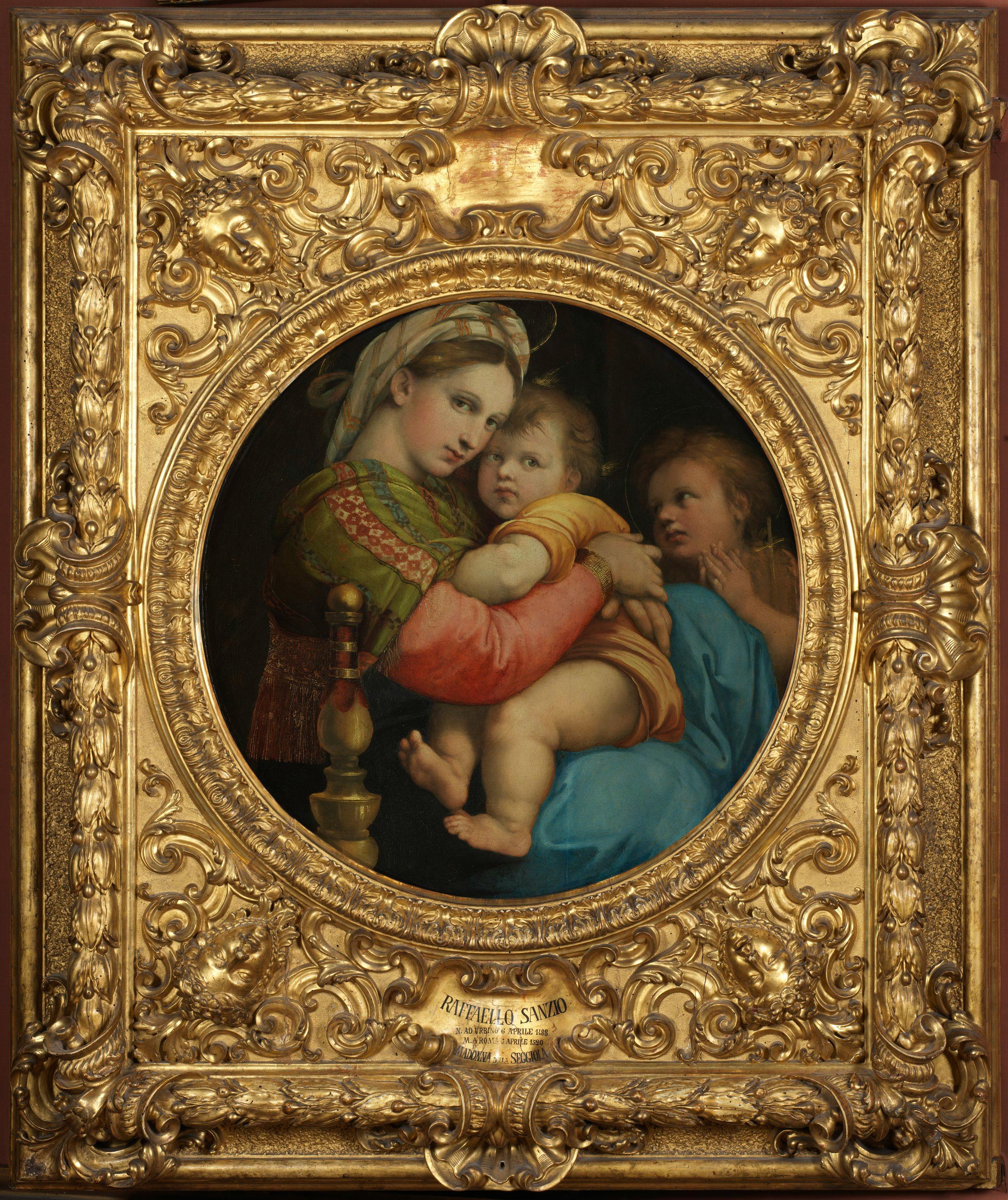Madonna and Child with St. John (known as Madonna of the Chair)
Raphael (Urbino 1483 - Rome 1420)
Mary is seen from the side, seated on a 'chamber chair', a type of seat reserved for the high dignitaries of the papal court. She just lifts one leg to better accommodate the body of her Son, clasping it against her chest, while St. John, on the right, casts an intense gaze at them, extending his hands in sign of prayer. The complex and formidable interlocking of the arms between mother and son, the slight inclination of Mary's face gently touching Jesus' temple while at the same time staring and attracting the viewer, generate a perfect play of correspondences accompanied by the colour combinations: from the white interwoven with golden wefts of the turban, to the symphonies of greens and reds of the Virgin's scarf; from the red of the sleeve juxtaposed with the yellow of the Child's tunic, to the ultramarine blue of the dress. The three figures are arranged in such a way as to follow the circular shape of the table with extraordinary naturalness, bound together not only by gestures but above all by the play of glances, each of which expresses with particular emotional nuance the veil of melancholy that accompanies this representation in which there is both the joy of childhood and the awareness of Christ's sacrifice as an adult. The dark background gives prominence to the trio of figures, illuminated from the right with a warm light that casts delicate shadows.
The ‘Madonna of the Chair’, as it has traditionally been called because of the particular furnishings that did not escape the attention of ancient scholars and travellers who passed through the Palatine Gallery, is one of Raphael's most brilliant inventions. Here he develops the embrace between Mary and Jesus in a complicated yet very natural way, continuing an investigation that had already begun with the Madonna Tempi (1508 circa, Alte Pinakothek in Munich) and was later repeated in variations in the Madonna of the Tent (1512-1513 circa, Alte Pinakothek in Munich). These compositions all stem from a model that was very important not only for Raphael, but also for many of his contemporary painters and sculptors: Donatello's Madonna and Child, which was owned by the Florentine merchant Piero del Pugliese and later became part of the Medici collections (The so-called "Dudley Madonna" is now in the Victoria and Albert Museum in London, A.84-1927). In that wafer-thin Donatello marble, Raphael had found the perfect inspiration to depict the relationship between the two protagonists with a sense of intimate everyday life, capturing especially the curving of the Virgin's head and the raised right leg on which the Child's back rests. Although experts over the past centuries have been divided into those who have read it primarily as expressions of human, even popular sentiments, and those who, on the contrary, have pointed to it as a pinnacle of Raphael's classicism, the originality of this painting lies precisely in the extraordinary combination of the human and the divine, in the lively and compelling manner in which the painter made his figures human and sacred at the same time. The solid structure of the bodies clearly represents Raphael's stylistic point of view in the early 1510s when, after finishing work on the Room of the Segnatura in the Vatican, he started work on the second of the Pope's rooms, the Room of Heliodorus, which he would finish circa 1514-15. It was a striking period, in which Raphael blended together his multiple Florentine experiences, the confrontation with Michelangelo's frescoes in the vault of the Sistine Chapel, and the reflection of Venetian painting through his encounter with Sebastiano del Piombo, with whom he had collaborated in the execution of the frescoes for Agostino Chigi's villa (today known as the ‘Farnesina’).
There are no certain documents as to who commissioned the painting, although the most accredited theories maintain that it could be Pope Leo X, known as Giovanni de' Medici (and indeed the orbs that decorate the uprights of the chair seem to allude to the Medici arms), or one of his closest cardinals. However, it is certain that the panel arrived to Florence at least in the last decades of the century, because it was placed in the Tribuna in 1589, together with two other masterpieces by Raphael, the Portrait of Leo X with Two Cardinals and the St. John the Baptist. At that time, it was still enclosed in a square gold-threaded wooden frame, completed at the four corners by brocatelle stone inlays, clearly visible in the ancient copies, including one made on copper in 1648 by Giovanna Garzoni (Inv. OdA Castello 1911 no. 502). The frame, which is now rectangular and encrusted with gilded carvings, was placed after the painting was moved from the Tribuna to Pitti Palace, ordered by Grand Prince Ferdinand who wanted to choose a private location for the Madonna of the Chair, and placed it in his bedroom.
S. Padovani, in Raffaello da Firenze a Roma, a cura di A. Coliva, Milano, 2006, pp. 129-130; S. Padovani in I dipinti della Galleria Palatina e degli Appartamenti Reali. Le Scuole dell’Italia Centrale 1450-1530, a cura di S. Padovani, Firenze 2014, pp.315-324.
